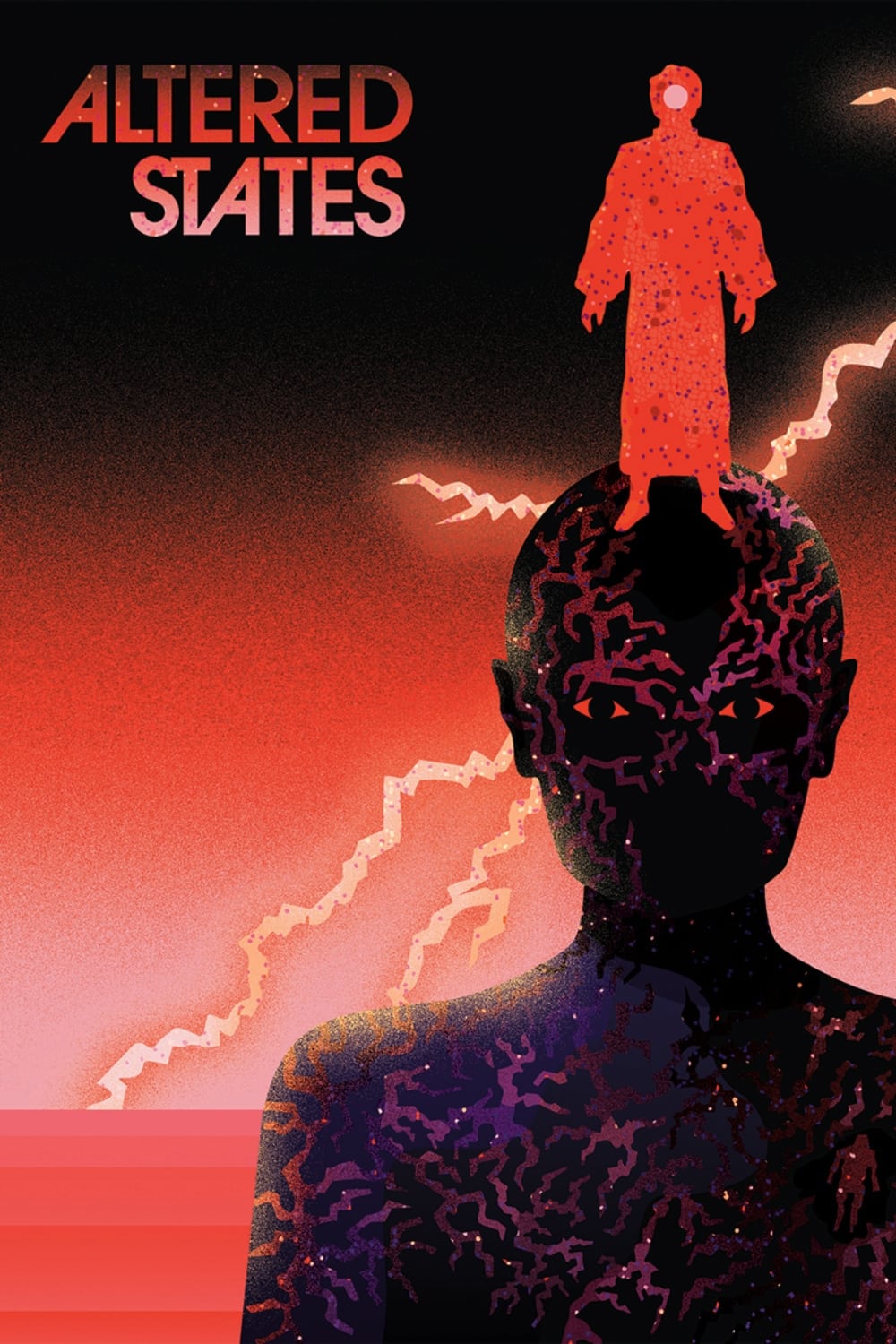Weird as hell, and then there is the Altered States. Ken Russell directed ‘Altered States,’ which was released in 1980. It is a science-fiction body horror film based on the same-named novel by playwright and screenwriter Paddy Chayefsky. After winning three Oscars, Paddy Chayefsky was recognized as one of Hollywood’s sharpest and brightest screenwriters. He ran away to Boston shortly after winning the Academy Award for Network in 1976 to begin work on his one and only novel.
John Cunningham Lilly’s work was partially based on the novel Altered States, published in 1978. (the neuroscientist that invented the isolation tank and pioneered New Age dolphin research). It was about a physiologist who used sensory deprivation and hallucinogenic medications to test the boundaries of human awareness. It was a serious and thought-provoking novel that went on to become a success.
In this film, William Hurt and Drew Barrymore made their film debuts. Russell and Chayefsky had a falling out during the production of the picture, which made it relatively famous. It became so serious that Chayefsky left the project and renamed himself “Sidney Aaron,” his genuine first and middle names.
When he heard his cry for help, it wasn’t human – Altered States (1980)

“Altered States” opens with a close-up shot of a shirtless William Hurt with wires sticking out of his hair and his head contained in a fish tank. The scene leaves one with a rather unsettling feeling, but it accurately sets the mood for the rest of the film. While it is his debut film, his acting doesn’t show it.
The movie follows a Harvard scientist Edward Jessup, a schizophrenia researcher, and psychopathologist. While researching schizophrenia, our psychopathologist protagonist begins to believe that “our other states of consciousness are as real as our waking states.” It is not a surprise, really, when he becomes enthralled by the idea of alternate states of awareness. With the help of two like-minded researchers, Arthur Rosenberg and Mason Parrish, he begins experimenting with sensory deprivation using a flotation tank to experiment with sensory deprivation. His experimental sensory deprivation included conducting tests on himself using a hallucinogenic drug and an isolation chamber, which we find out later might be causing him to genetically regress.
Like most academics, he meets Emily, a fellow “whiz kid” who is also a Cornell University classmate at a faculty party. She can clearly be pegged as Jessup’s type based on his actions and behavior. Furthermore, it becomes apparent when he says, “Anthropology seems to attract good-looking women.”
She comes on to him seconds later, asking things like, “You believe craziness is just another level of consciousness?” which obviously reels him in even more. The question that Emily raises pertains more to the film than to the audience; after all, lunacy, as we see, is the state of being in which this cinematic universe exists. In “Altered States,” anything is possible, and this film goes on to prove that to us.
We fast forward to seven years now, and Edward and Emily have two daughters. Unfortunately, they are on the verge of divorce when they reunite with the couple that first introduced them at the party. Edward flies to Mexico to attend a ceremony held by the Hinchi tribe after finding out that members of the tribe have shared similar hallucinogenic states that he, too, had experienced during his experiments.
While he is in Mexico, Edward hires a guide, Eduardo Echeverria. They climb up into the Hinchi hill country, a plateau covered in spectacular mushroom-shaped ventifacts, where Eduardo tells him that the Hinchi use a potion containing the sacred mushroom Amanita muscaria and the shrub Sinicuiche, also known as Heimia salicifolia, which they are collecting to use in next year’s ceremonies. Heimia salicifolia can trigger deep memory states because of which the tribe has given it the Hinchi name. The Hinchi name means “first or primordial flower.” An indigenous elder (dubbed “the brujo” in the movie) is seen holding a root (probably a Heimia root) in his hand. He asks Edward to hold the root before cutting his hand to add some blood to the combination he is cooking.
Shortly after drinking the concoction, Edward has weird and severe hallucinations, including one of Emily and himself being petrified and then eroded by blown sand. Edward leaves the Hinchi plateau under a cloud the following day, after having murdered a large specimen of the Hinchi’s sacred monitor lizard while inebriated by the concoction.
A dream sequence shows that the natives believe the monitor lizard to have given them the sacred mushroom in the mythic past, which is shown in rock carvings. He returns to the United States with a sample of the Hinchi potion for study by his colleagues and additional self-experimentation because he obviously hasn’t realized the intensity of its effects despite the reaction he experienced, and he continues to consume it to further his exploration of altered states of consciousness.
While the film’s obsession with LSD-infused psychedelia may make it seem like a cliched ’60s nostalgia trip, the opening title sequence alone remains as relevant today as it did almost 40 years ago when it was first released. While never as straightforward or moralistic as an anti-drug film, the story of a scientist succumbing to a dangerous research obsession is tinged with broader cultural concerns about a return to the 1960s’ dippy-hippy mysticism, far from what was hoped to be the comparatively “enlightened” decade to come in 1980.
When increased dosage becomes unsafe due to toxic quantities of the chemical, Edward returns to sensory deprivation, believing it will boost the benefits of the medication at his current level. Edward utilizes a derelict tank in a medical school to have a series of more terrifying visions, including one of early Hominidae while repairing it. Edward, who is being watched by his co-workers, claims that his visions have “externalized.” Edward insists on being X-rayed before he “reconstitutes,” his mouth bloodied and hurriedly making notes because he is unable to talk. A radiologist who examined the X-rays concluded that they belonged to a gorilla.
Edward goes through physical-biological devolution in later studies. He emerges from the isolation tank as a feral, small-statured, light-skinned caveman at one point, rampaging around the town’s streets before resuming his regular shape. Edward’s co-workers are stunned by an energy wave unleashed by the experiment, which (thankfully) also destroys his tank. Edward persists in his efforts despite his co-workers’ concerns. Edward has a more profound retreat in the final experiment, evolving into an amorphous mass of an aware, primeval substance which, honestly, reminds me a little bit of an amoeba.
When Emily arrives, the tank has been replaced with a spinning vortex. She explores the vortex for Edward, finding him just as he is about to transform into a non-physical form of proto-consciousness and possibly vanish from our version of reality.
Edward is brought home by his buddies in the hopes that the transformations will stop. However, he begins to uncontrollably regress once more, with the mutations no longer requiring the ingestion of “first flower” or sensory deprivation. Emily clutches Edward’s hand, urging him to fight the shift, and is soon engulfed by Edward’s primeval force. The sight of Emily, who appears to be being consumed by the energy, awakens Edward’s devolving form’s human consciousness. He resists the metamorphosis and reverts to his original human state. As Emily returns to normal, Edward embraces her.
The central topic of Altered States is the human desire to leave the body behind, be reborn, and experience things that were once considered heavenly in mind. William Hurt’s outstanding performance as Jessup conveys this intellectual’s unabashed egotism as well as his Promethean desire to unravel life’s mysteries. On a side note, one should definitely check out the works of John Lilly, Robert Ornstein, Andrew Weil, Carlos Castaneda, E. L. Masters, Aldous Huxley, and Jean Huston if they are interested in the subject of altered states of consciousness.
The entire thing is a stunning concept, but “Altered States” doesn’t slow down to accommodate it. It develops into a farce just as it starts to sound like a 1960s psychedelic vision, a head trip. When a scientist spends too much time in his tank, he regresses to a simian state, physically transforms into an ape, attacks campus security guards, is chased into the local zoo by a pack of wild dogs, and kills and eats a sheep for supper before reverting to being the benevolent Professor Jessup, our own version of The Intellectual Hulk.
Why should you watch the Altered States?

The film is an enticing enigma. It draws one in like a tornado, except you enjoy every second of it. It is a weird film, but it challenges not only the perceptions of reality and also gives us a terrifying perspective on our bodies and brains. It has a Lovecraftian feel to it with the rapidly decaying and regressing nature of Jessup’s body. It feels scary to watch since every aspect of it is so wildly unknown and unexplored. It gives a wonderfully chilling feeling throughout.
The film is divided into three main components: science, spectacular effects, and the professor’s love relationship with his wife. The science is presented in a delectable manner. We learn about total immersion, genetics, and racial memory as much as we need to know (which is next to none). The extraordinary effects are then presented in four long sections and a few quick bursts. They’re excellent.
They are meant to evoke the birth of the universe in a throbbing celestial ovum, and they may remind you of the sound-and-light spectacle at the end of 2001. Dr. Jessup is at the center of the image, his body pulsing in and out of an ape shape, his mouth drawn into an anguished “O” as he screams the hell of birth. The soundtrack reinforces these sequences, which are clearly meant to feed the next generation of cinema cultists’ chemically altered consciousness.
Then there’s the matter of the professor’s love relationship with his wife, and it’s here that we see just how strong love’s magnetism can be. Despite having filed for divorce, he continues to show this magnetism. It is his wife who wades into the cosmic mists, goes up to her knees in eternity, reaches in, and pulls him out during the professor’s final experiment when he is vanishing into a terrible vortex of light and cries on the laboratory floor.
The professor transforms into the protoplasm of life itself. In contrast, his wife transforms into a brilliant shell of rock-like flesh, with her inner fires glowing through the fissures, in the last scene (the effect is something like an overheated Spiderman). As the professor, as Man, bangs on the walls and crawls toward her, and she reaches out, and the world rocks, the Man within him bursts out of the ape-protoplasm, and the Woman within her explodes back into flesh, and they collapse into each other’s arms.
Russell created a story about the fascination and eventual hazards of meddling with the buried enigmas of the unconscious. The altered States requires that the viewer yield to the force of these hallucinations nearly as much as Jessup does, and Russell revels in the hyper-theatricality and extravagant symbolism that seem to have become his trademark as a director.
From this vantage point, Altered States’ textures and surfaces reveal as much about Russell’s vision as the plot or characters: like most of his films, this is a film to feel and sense our way through. And no one did it quite like Roger Ebert, the director of ‘The Lighthouse’ (which we have covered before, so do check it out!), so aptly put it, “Altered States was the movie Ken Russell was born to direct.”
It is a beautifully created movie despite the conflicts between Chayefsky and Russell. It is genuinely a movie well beyond its time. It gives a subtle message about drug abuse without being political or offensive while weaving a terrifying tale of fiction. It is a much watch for people who enjoy slow-burn insanity. Russell and William Hurt have done a great job on the film.
